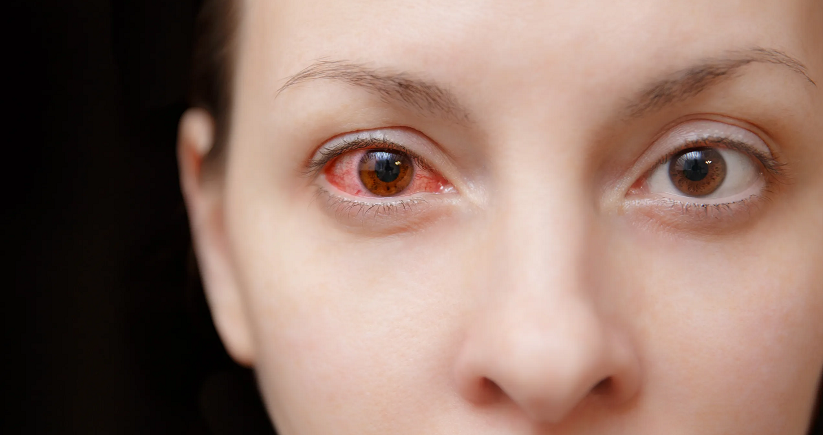Pink eye, also known as conjunctivitis, is a common eye condition that can cause redness, itching, and discharge in one or both eyes. It occurs when the conjunctiva, the thin, transparent layer of tissue lining the inner surface of the eyelid and covering the white part of the eye, becomes inflamed. There are several types of conjunctivitis, each with distinct causes, symptoms, and treatments. Let’s explore the four types: viral, bacterial, allergic, and fungal conjunctivitis, providing information on how to identify and treat each type.
Take our pink eye quiz if you think you have pink eye, and schedule an eye exam with one of our Board-certified eye doctors for pink eye treatment and relief.
What actually is Pink Eye?
Overview
Pink eye is an inflammation of the conjunctiva that leads to redness and swelling of the eye and the inner eyelid. This condition is highly contagious and can affect people of all ages, though it is particularly common in children. While pink eye is usually a mild condition, it can sometimes cause more serious complications if not properly treated.
Symptoms
The symptoms of pink eye can vary depending on the cause, but common signs include:
- Redness in one or both eyes
- Itchiness in one or both eyes
- A gritty feeling in the eyes
- Discharge that forms a crust during sleep
- Tearing

Types of Pink Eye
Viral Conjunctivitis
Causes
Viral conjunctivitis is caused by viruses, most commonly adenoviruses. It can also be associated with the common cold or other upper respiratory tract infections. This type of pink eye is highly contagious and can spread through direct or indirect contact with the infected individual’s eye secretions. This tends to affect adults the most.
Symptoms
- Watery discharge
- Redness
- Itchiness
- Sensitivity to light
- Swollen lymph nodes near the ear (in some cases)
Treatment
There is no specific treatment for viral conjunctivitis. The condition typically resolves on its own within a few days, up to a week. However, to relieve symptoms, you can:
- Use artificial tears to soothe irritation
- Apply a cold compress to reduce swelling
- Avoid touching or rubbing your eyes
- Practice good hygiene, such as frequent handwashing and using clean towels and pillowcases
Bacterial Conjunctivitis
Causes
Bacterial conjunctivitis is caused by bacteria such as Staphylococcus aureus, Streptococcus pneumoniae, and Haemophilus influenzae. This type of pink eye is also highly contagious and can spread through contact with contaminated hands, objects, or respiratory droplets. This tends to affect children the most.
Symptoms
- Thick, yellow or greenish discharge
- Redness
- Swelling of the conjunctiva
- Mild pain or discomfort
- Crusting of the eyelids, especially in the morning
Treatment
Bacterial conjunctivitis often requires antibiotic treatment to clear the infection. Your doctor may prescribe antibiotic eye drops or ointments. To manage symptoms and prevent the spread of infection:
- Follow the prescribed antibiotic regimen
- Use a warm compress to remove crusts from the eyelids
- Avoid touching or rubbing your eyes
- Practice good hygiene
Allergic Conjunctivitis
Causes
Allergic conjunctivitis occurs when the eyes react to allergens such as pollen, dust mites, pet dander, or mold. This type of pink eye is not contagious and is often associated with other allergic conditions like hay fever or asthma.
Symptoms
- Redness
- Itchiness
- Watery discharge
- Swelling of the conjunctiva
- Sneezing and nasal congestion (in cases of allergic rhinitis)
Treatment
The primary approach to treating allergic conjunctivitis is to avoid the allergens causing the reaction. Additionally, treatment may include:
- Over-the-counter or prescription antihistamine eye drops
- Artificial tears to flush out allergens
- Applying a cold compress to reduce swelling and irritation
- Taking oral antihistamines or nasal sprays for systemic allergy relief
Fungal Conjunctivitis
Causes
Fungal conjunctivitis is relatively rare and is caused by fungi such as Candida, Aspergillus, or Fusarium. This type of pink eye can result from exposure to contaminated contact lenses or ocular trauma involving plant matter. This is the most dangerous type of pink eye and can be considered a medical eye emergency.
Symptoms
- Redness
- Pain
- Thick discharge
- Swelling of the conjunctiva
- Blurred vision
Treatment
Fungal conjunctivitis requires prompt medical attention and treatment with antifungal medications. Your doctor may prescribe antifungal eye drops or oral antifungal drugs. Additionally, management includes:
- Maintaining good eye hygiene
- Avoiding the use of contaminated contact lenses
- Following your doctor’s treatment plan closely
Preventing Pink Eye
Preventing the spread of pink eye involves good hygiene practices and taking precautions to avoid contact with infected individuals. Here are some tips to help prevent the transmission of conjunctivitis:
- Wash your hands frequently with soap and water
- Avoid touching or rubbing your eyes
- Do not share personal items such as towels, washcloths, or eye makeup
- Clean and disinfect surfaces that may be contaminated
- If you wear contact lenses, follow proper lens care and hygiene guidelines
- Stay home from work, school, or daycare if you have contagious conjunctivitis
Keep Your Eyes Healthy
Pink eye, or conjunctivitis, is a common and often contagious condition that can cause discomfort and inconvenience. Understanding the different types of conjunctivitis—viral, bacterial, allergic, and fungal—can help you identify the symptoms and seek appropriate treatment. Whether it’s managing a viral infection with supportive care, using antibiotics for bacterial conjunctivitis, avoiding allergens for allergic conjunctivitis, or seeking prompt medical attention for fungal conjunctivitis, proper diagnosis and treatment are crucial for recovery.
At Optical Illusions: An Optometric Practice, we are committed to providing exceptional eye care. Our experienced optometrists use state-of-the-art technology to diagnose and treat through our medical eye exams. Don’t wait until symptoms get worse—schedule your eye exam today and take proactive steps towards safeguarding your vision and health. Contact our team to schedule your appointment at 1 of our 4 conveniently located offices.



